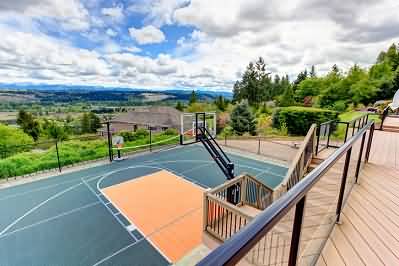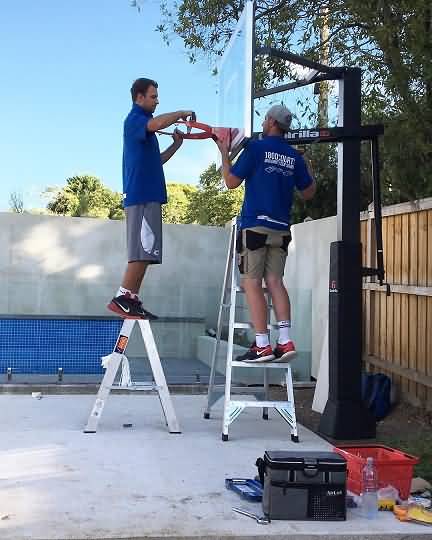Turning Your Backyard into a Basketball Court
By Rocio Espinoza of Porch.comDisclosure: This page contains affiliate links, which means that Coach's Clipboard receives a small commission (at no cost to you) if you make a purchase using these links.

Basketball Court: Size and Location
An NBA-grade basketball court measures 28m x 15m, but that’s typically too large for the average backyard. Of course, if you have the 420 sqm to spare, you can undoubtedly take the professional route. On the other hand, many backyard courts feature smaller dimensions. A regulation-size half-court measures 15m x 11m, but you can go even smaller if you choose.
Inspect your yard with a tape measure in hand. You may want to use yarn to section off an area for your court to encompass. This will help you determine what dimensions your space can accommodate. If your court is too large, you may not have much space left for spectators or to set up chairs and tables for viewing. Also, if possible, choose reasonably flat ground; otherwise, you’ll have a more challenging job of leveling the court. You might find you need to hire professionals to tackle the earth excavation for you.
Level the Ground
A basketball court requires a flat foundation. Before you can pour concrete, you’ll need to dig up the ground and ensure that it’s level. If you intend for your court to be at ground surface level, you should excavate 117mm to accommodate your concrete slab. On the other hand, if you prefer an elevated slab for your court, you’ll only need to remove grass and level the ground. You won’t have to excavate. If you do choose to excavate, you should contact your utilities; there may be cables and sewer lines buried in the vicinity of your court. You’ll need to determine if any lines are present, so you don’t disturb them.
Choose Your Court Surface and Hoops
Before you pour concrete for your court’s foundation, be sure to order your hoops if you want to anchor them into your concrete. Mounting them in the concrete will give your court a professional look. Your concrete slab provides a durable foundation for your court, but you may want to adorn it with a synthetic sports surface. Rubber or polymer sports tiles make for an excellent court experience and are typically more durable than turf. If you choose asphalt, you’ll want to seal it after painting its lines to promote its longevity.
Install Your Court and Paint Lines
Once you have your materials, you can construct your court according to the dimensions you mapped out. Again, you may want to invite a contractor to perform some work, such as pouring the concrete for your slab. After the concrete has cured (allow for 72 hours), you can install your court’s surface. Many tile systems are available in the marketplace, so choose one that meets your needs and preferences. Once your surface tiles are in place, you’re ready to mark out the court’s lines carefully. Use a tape measure and tape to mark gameplay lines as well as the court’s borders. Then, you can paint them. You can use a basketball court stencil kit to ensure that your markings are perfect.
Accessorize Your Basketball Court
Consider painting a custom logo in the center of your court to personalize your space. You might also want to invest in netting to set up behind your hoops to keep the basketball in the court space, especially if you live near neighbors. Add some outdoor court-style seating for your players and spectators to complete your basketball court.
Basketball Court Maintenance
To maintain your basketball court’s good condition, be sure to pressure wash it annually or every other year. This will allow you to remove dirt or other ground-in debris. Otherwise, simply keep leaves and twigs off the court by inspecting it routinely. If your basketball court is enjoyed routinely, you may need to have it resurfaced every four to five years.

Related pages: